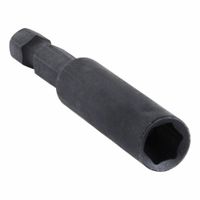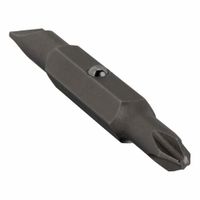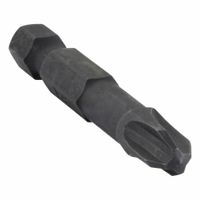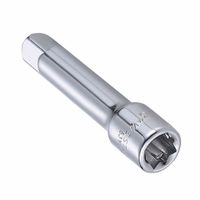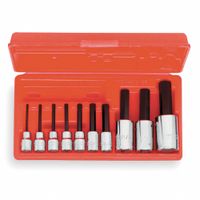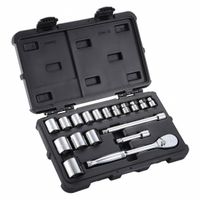Call +(254) 703 030 000 / 751 483 999 / 721 704 777
.....Read More
Frequently Asked Questions
What are the different types of screwdriver bits and their uses?
Screwdriver bits come in various types, each designed for specific screw heads and applications:
1. **Phillips (PH):** Features a cross-shaped tip. Commonly used in household and electronic devices due to its self-centering design, which reduces slippage.
2. **Flathead/Slotted:** Has a flat, straight blade. Used for simple screws in furniture and electrical applications, though it can slip easily.
3. **Pozidriv (PZ):** Similar to Phillips but with additional lines between the cross. Offers better torque and reduced cam-out, ideal for woodworking and construction.
4. **Torx (T):** Star-shaped with six points. Provides high torque transfer and is used in automotive, electronics, and appliances.
5. **Hex/Allen:** Hexagonal shape. Common in furniture assembly and bicycles, offering good torque and a snug fit.
6. **Square/Robertson:** Square-shaped tip. Known for its high torque and reduced slippage, often used in woodworking and construction.
7. **Security Torx (Tamper-Resistant):** Similar to Torx but with a pin in the center. Used in security applications to prevent tampering.
8. **Tri-Wing:** Three-winged tip. Used in electronics and aerospace to prevent unauthorized access.
9. **Torq-Set:** Offset cruciform design. Used in aerospace and military applications for high torque.
10. **Spanner/Pinhead:** Two-pin design. Used in security applications to prevent tampering.
11. **Clutch Type:** Bow-tie shape. Common in older vehicles and appliances.
12. **JIS (Japanese Industrial Standard):** Similar to Phillips but designed for Japanese products, reducing cam-out.
Each bit type is designed to fit specific screw heads, ensuring efficient torque transfer and minimizing damage to the screw or work surface.
How do I choose the right socket size for a fastener?
To choose the right socket size for a fastener, follow these steps:
1. **Identify the Fastener Type**: Determine if the fastener is metric or imperial. Metric fasteners are measured in millimeters, while imperial fasteners are measured in inches.
2. **Measure the Fastener**: Use a caliper or a ruler to measure the width across the flats of the fastener head. This is the distance between two parallel sides of the fastener head.
3. **Match the Measurement**: Compare the measurement to a socket size chart to find the corresponding socket size. For metric fasteners, match the millimeter measurement to the nearest socket size. For imperial fasteners, convert the measurement to inches if necessary and match it to the nearest socket size.
4. **Check Fit**: Test the socket on the fastener. It should fit snugly without excessive play. A loose fit can strip the fastener, while a tight fit may not fit over the fastener head.
5. **Consider Drive Size**: Ensure the socket drive size matches your ratchet or wrench. Common drive sizes are 1/4", 3/8", 1/2", and 3/4". The drive size should be appropriate for the torque required.
6. **Use Socket Sets**: If unsure, use a socket set that includes a range of sizes. This allows you to try different sockets until you find the perfect fit.
7. **Quality and Material**: Choose sockets made from durable materials like chrome vanadium steel for longevity and strength.
8. **Specialty Fasteners**: For specialty fasteners, such as Torx or Allen, use the corresponding socket type designed for those fasteners.
By following these steps, you can accurately select the right socket size for your fastener, ensuring efficient and safe work.
What is the difference between a nutsetter and a nut driver?
A nutsetter and a nut driver are both tools used for tightening or loosening nuts and bolts, but they differ in design, application, and usage.
A nutsetter is typically an attachment used with power tools like drills or impact drivers. It consists of a hexagonal shank that fits into the chuck of the power tool and a socket head that fits over the nut or bolt. Nutsetters are designed for high-speed applications and are ideal for repetitive tasks, such as in assembly lines or construction, where efficiency and speed are crucial. They are often magnetic, which helps hold the nut in place during installation. Nutsetters are available in various sizes to accommodate different nut dimensions and are commonly used in professional settings.
On the other hand, a nut driver is a hand tool that resembles a screwdriver but with a socket head instead of a flat or Phillips tip. It is used manually to turn nuts and bolts and is ideal for tasks requiring precision and control. Nut drivers are often used in electronics, appliance repair, and other applications where delicate handling is necessary. They provide a good grip and allow for controlled torque, reducing the risk of over-tightening. Nut drivers come in sets with different sizes to fit various nuts and bolts.
In summary, the primary difference lies in their operation: nutsetters are power tool attachments for fast, repetitive tasks, while nut drivers are manual tools for precision work. Nutsetters are suited for high-volume industrial use, whereas nut drivers are more appropriate for detailed, careful applications.
How do socket adapters and extensions work?
Socket adapters and extensions are tools used to enhance the functionality and reach of socket wrenches, which are essential in tightening or loosening fasteners like nuts and bolts.
Socket adapters are designed to connect sockets of different drive sizes to a wrench or ratchet. They allow for the interchangeability between different socket sizes, enabling a single wrench to accommodate various socket sizes. For example, a 3/8-inch drive ratchet can be used with a 1/4-inch drive socket by using a reducing adapter, or with a 1/2-inch drive socket using an enlarging adapter. This versatility reduces the need for multiple ratchets and sockets, saving space and cost.
Extensions, on the other hand, are used to increase the reach of a socket wrench. They are particularly useful in accessing fasteners located in deep or hard-to-reach areas, such as within engine compartments or behind obstructions. Extensions come in various lengths, allowing users to select the appropriate length for the task. They connect between the ratchet and the socket, transmitting the torque from the wrench to the fastener.
Both socket adapters and extensions are typically made from durable materials like chrome vanadium steel to withstand the torque applied during use. They are designed to fit securely, minimizing the risk of slipping or rounding off fasteners. Some extensions also feature a wobble or flex design, providing additional maneuverability in tight spaces.
In summary, socket adapters and extensions enhance the functionality of socket wrenches by allowing compatibility with different socket sizes and extending reach, respectively, making them indispensable tools in automotive, construction, and maintenance tasks.
What are the benefits of using double-ended screwdriver bits?
Double-ended screwdriver bits offer several benefits that enhance efficiency and convenience in various applications. Firstly, they provide versatility by featuring two different types or sizes of tips on each end, allowing users to switch between them quickly without needing to change the bit. This is particularly useful in tasks requiring multiple screw types, saving time and reducing the need to carry multiple bits.
Secondly, double-ended bits are cost-effective. Instead of purchasing two separate bits, users get two functionalities in one, which can be more economical. This dual functionality also means fewer bits to store and manage, simplifying tool organization.
Durability is another advantage. Double-ended bits are often made from high-quality materials designed to withstand wear and tear. If one end becomes worn or damaged, the other end can still be used, extending the overall lifespan of the bit.
Additionally, these bits are space-saving. For professionals and DIY enthusiasts who need to carry a variety of tools, double-ended bits reduce the number of individual bits required, making toolkits lighter and more compact.
Finally, double-ended bits can enhance productivity. The quick-switch capability minimizes downtime between tasks, allowing for a more seamless workflow. This is particularly beneficial in high-paced environments where efficiency is crucial.
In summary, double-ended screwdriver bits offer versatility, cost-effectiveness, durability, space-saving benefits, and enhanced productivity, making them a valuable addition to any toolkit.
How do I properly secure a bit in a power drill?
To properly secure a bit in a power drill, follow these steps:
1. **Select the Right Bit**: Choose a bit that matches the task and fits the drill's chuck size.
2. **Power Off**: Ensure the drill is turned off and unplugged if it's corded, or the battery is removed if it's cordless, to prevent accidental activation.
3. **Open the Chuck**:
- For a keyless chuck, grip the chuck with one hand and rotate it counterclockwise to open the jaws.
- For a keyed chuck, insert the chuck key into the hole on the side of the chuck and turn it counterclockwise to open the jaws.
4. **Insert the Bit**: Place the shank (smooth end) of the bit into the center of the chuck. Ensure it is straight and not tilted.
5. **Tighten the Chuck**:
- For a keyless chuck, hold the drill handle with one hand and rotate the chuck clockwise with the other hand until the bit is securely clamped.
- For a keyed chuck, insert the chuck key and turn it clockwise to tighten the jaws around the bit. Use all the holes on the chuck to ensure even tightening.
6. **Check Security**: Gently pull on the bit to ensure it is firmly secured and does not wobble.
7. **Test the Drill**: Power on the drill briefly to ensure the bit spins correctly without wobbling.
8. **Adjust if Necessary**: If the bit wobbles or is loose, repeat the tightening process.
By following these steps, you ensure the bit is securely fastened, reducing the risk of accidents and improving drilling accuracy.
What is the purpose of a bit holder?
A bit holder is a tool accessory designed to securely hold and facilitate the use of interchangeable screwdriver bits, drill bits, or other tool bits. Its primary purpose is to enhance the versatility, efficiency, and convenience of power tools and manual screwdrivers.
Bit holders typically feature a magnetic or mechanical locking mechanism that ensures the bit remains firmly in place during operation, preventing it from slipping or falling out. This secure grip is crucial for maintaining precision and control, especially when working with power tools that operate at high speeds.
The use of a bit holder allows for quick and easy swapping of bits, which is particularly beneficial in tasks that require multiple types of screws or fasteners. This adaptability reduces downtime and increases productivity, as users can swiftly change bits without needing to switch tools entirely.
Bit holders also extend the reach of the tool, allowing users to access tight or hard-to-reach spaces that might be difficult to navigate with a standard screwdriver or drill. This extended reach is often essential in construction, carpentry, and DIY projects where space constraints are common.
Moreover, bit holders can help protect the bits and the work surface. By providing a stable connection, they minimize the risk of stripping screws or damaging materials, which can occur if the bit slips or wobbles during use.
In summary, the purpose of a bit holder is to provide a secure, efficient, and versatile means of using interchangeable bits with power tools and manual screwdrivers, enhancing precision, productivity, and accessibility in various applications.
How do I determine the correct torque for a fastener?
To determine the correct torque for a fastener, consider the following steps:
1. **Identify Fastener Specifications**: Determine the size, grade, and material of the fastener. This information is crucial as different materials and grades have varying strength and torque requirements.
2. **Consult Manufacturer Guidelines**: Refer to the fastener manufacturer's specifications or technical data sheets. These documents often provide recommended torque values based on the fastener's material and size.
3. **Use Torque Charts**: Utilize standard torque charts available for different fastener types and materials. These charts provide torque values based on the fastener's diameter, thread pitch, and material.
4. **Consider Joint Material**: The material of the components being joined can affect the torque. Softer materials may require lower torque to prevent damage, while harder materials can withstand higher torque.
5. **Account for Lubrication**: If the fastener or joint is lubricated, adjust the torque value. Lubrication reduces friction, which can lead to over-tightening if not accounted for. Typically, reduce the torque by 10-20% for lubricated fasteners.
6. **Use Torque Calculators**: Online torque calculators can provide precise torque values based on input parameters like fastener size, material, and lubrication.
7. **Apply Engineering Judgment**: Consider the application and environment. Critical applications may require precise torque control, while non-critical applications may allow for a broader range.
8. **Perform Testing**: Conduct tests to verify the torque setting. This is especially important for critical applications where failure could have significant consequences.
9. **Follow Standards**: Adhere to industry standards such as ISO, ASME, or SAE, which provide guidelines for torque specifications.
10. **Use a Torque Wrench**: Always use a calibrated torque wrench to apply the specified torque accurately. Regularly calibrate the wrench to ensure precision.
What are the advantages of using socket bits over traditional sockets?
Socket bits offer several advantages over traditional sockets:
1. **Versatility**: Socket bits can be used with a variety of tools, such as power drills and screwdrivers, making them more versatile than traditional sockets, which typically require a ratchet or wrench.
2. **Compactness**: Socket bits are generally smaller and lighter than traditional sockets, making them easier to store and transport. This compactness is particularly beneficial for mobile toolkits and for use in tight spaces.
3. **Efficiency**: When used with power tools, socket bits can significantly speed up the process of tightening or loosening fasteners, as they allow for rapid rotation and require less manual effort compared to using a ratchet with traditional sockets.
4. **Accessibility**: The design of socket bits allows them to reach fasteners in confined or hard-to-reach areas where traditional sockets might not fit due to their bulkier design.
5. **Cost-Effectiveness**: Socket bit sets are often more affordable than full sets of traditional sockets and ratchets, providing a cost-effective solution for those who need a wide range of sizes without investing in multiple tools.
6. **Ease of Use**: Socket bits can be quickly swapped out in a drill or driver, reducing downtime and making it easier to switch between different sizes or types of fasteners.
7. **Precision**: When used with a torque-controlled power tool, socket bits can provide more consistent and precise torque application, reducing the risk of over-tightening or damaging fasteners.
8. **Durability**: High-quality socket bits are made from durable materials that can withstand the high torque and speed of power tools, offering longevity and reliability.
Overall, socket bits enhance efficiency, versatility, and convenience, making them a valuable addition to any toolkit.
How do I maintain and care for my socket and bit set?
To maintain and care for your socket and bit set, follow these steps:
1. **Cleaning**: After each use, wipe down sockets and bits with a clean, dry cloth to remove dirt, grease, and debris. For stubborn grime, use a mild detergent and water, then dry thoroughly to prevent rust.
2. **Lubrication**: Apply a light coat of machine oil or a rust-preventive spray to metal parts to protect against corrosion. Focus on moving parts like ratchets and hinges.
3. **Storage**: Store your set in a dry, cool place. Use the original case or a dedicated tool organizer to keep pieces in order and prevent loss. Ensure the storage area is free from moisture to avoid rust.
4. **Inspection**: Regularly inspect sockets and bits for wear or damage. Look for cracks, rounding, or deformation. Replace any compromised tools to ensure safety and effectiveness.
5. **Proper Use**: Use the correct size socket or bit for the job to prevent stripping or damaging both the tool and the fastener. Avoid using sockets with power tools unless they are specifically designed for that purpose.
6. **Avoid Over-Torquing**: Use a torque wrench when necessary to avoid applying excessive force, which can damage sockets and bits.
7. **Organization**: Keep your set organized by size and type. This not only makes it easier to find the right tool but also helps in quickly identifying any missing pieces.
8. **Avoid Exposure to Elements**: Keep your tools away from extreme temperatures and direct sunlight, which can degrade materials over time.
By following these maintenance tips, you can extend the life of your socket and bit set, ensuring they remain reliable and efficient for future projects.
